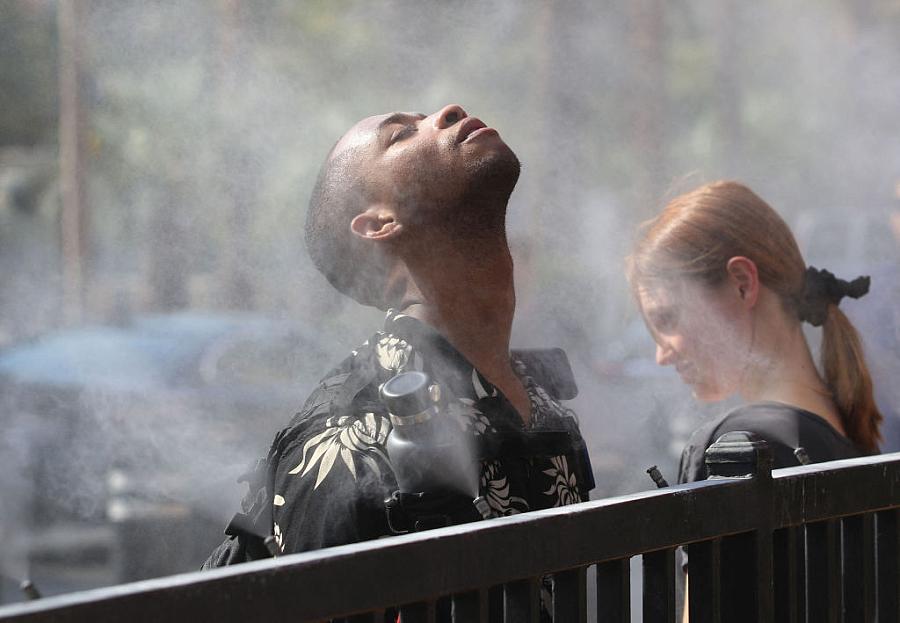Extreme heat is a quiet health crisis worth covering, LA Times investigation shows

As extreme heat waves have become more common in California, Los Angeles Times reporters started asking questions about the real death toll.
But state public health officials couldn’t tell them how many people had died from heat or related causes, a striking lack of data for a growing health hazard.
“That really stoked our curiosity,” said Times journalist and longtime environmental reporter Tony Barboza in a Center for Health Journalism webinar this week.
These hidden deaths became the focus of a yearlong investigation into the health impact of California’s changing climate and the disparate toll on some communities. Barboza and colleague Anna M. Phillips shared their reporting and data analysis and offered valuable tips on how other reporters can tackle climate-change related heat stories in their own communities.
An underreported story
California’s records show heat exposure caused 599 deaths between 2010 to 2019, the hottest decade on record. But the reporters questioned whether those numbers accurately told the full story. For example, someone might have died from a heart attack or stroke triggered by the heat, though that important detail wouldn’t necessarily be reflected in the death certificate.
So, they decided to conduct their own analysis – with crucial help from epidemiologists — looking at excess deaths during heat events. That analysis ultimately found 3,900 heat-related deaths during that same period, more than six times higher than the official count.
Arriving at this higher figure was a long and painstaking process. Phillips, an environmental policy reporter, spent a month seeking an epidemiologist interested in collaboration, a tall order during a global pandemic. Eventually, they found a University of Washington researcher who offered the help of a graduate student.
To arrive at a more accurate number of heat-related deaths, the team examined “excess deaths” during these extreme events — the difference between recorded deaths during a given period of time and what would be normally expected. But that involves a complex and detailed analysis that might change region by region. For example, people in San Francisco and Riverside County might react very differently to a 95-degree day.
Afterward, they took their findings to several other environmental epidemiologists who offered more feedback and refinements over several months before the team felt confident about their findings.
Finding protagonists
Armed with data, reporters searched for people who could put a human face on these invisible deaths. They sent public records requests to all 58 counties and gathered lists for hundreds of people who had died from heat. Those death certificates provided leads they could pursue to find families of heat death victims. But the next step was harder.
“A lot of the family members felt a bit of shame around how their loved ones had died,” Barboza said. “It was hard to coax folks to share their stories.”
Ultimately, the reporters appealed to their desire to help others avoid the same tragic fate as their family members. Their efforts eventually paid off and they were able to share tragic stories such as Jorge Valerio-Santiago’s death from heat stroke while working outside digging trenches in Riverside County.
They also sought stories that would reveal the larger story of disparities, Barboza said, showing a satellite heat map of Los Angeles County. On a typical summer day, there are urban heat islands that don’t follow prevailing weather patterns. Poorer areas with less tree canopy and more concrete can experience much higher temperatures even within the same city, and racist housing practices from nearly a century ago still correspond to hotter areas today.
The journalists also pounded the pavement to find sources, visiting residences during an especially hot week. Neighbors shared vivid details such as their teenage daughter asking for an air conditioning unit for graduation.
Meanwhile, Phillips explored increased heat in the workplace, focusing on a large Rite-Aid warehouse in the Antelope Valley, where temperatures would soar into the 90s and simmer there for hours. In response to the sweltering conditions, the company had installed some fans, she said. Workers suffering from excessive heat would seek relief in the warehouse’s chocolate room, where temperatures were kept lower to keep the inventory from melting.
Phillips zeroed in on one warehouse experience to showcase the intentional choices involved in creating that work environment.
“This is a decision that was made not to air condition this facility,” she said.
Localize the heat story
The Times team offering tips on how reporters might embark on a related investigation in their own community.
The coroner’s office is often the best place to start. Once you have gathered death certificates, you can search for families who may share their story. If the records requests become expensive, consider asking for a list instead of a detailed report. Always push back if the cost becomes prohibitive, Barboza said.
“Explain you’re doing this for the public, in the public interest and sometimes they’ll let it slide,” he said.
He also advised reporters to collaborate with local researchers who might have shared interests.
Even if there is a discouraging lack of data on heat deaths and illness, consider making that part of the story. Missing data matters especially if it’s obscuring the extent of the health impact. Finally, he urged reporters be persistent on a topic that can have a real if overlooked impact on people’s lives.
Better data can translate into targeted interventions and better warnings before an event. If people are more aware of the potential impact, they may be less likely to check on elderly neighbors. On a policy level, cities might consider steps such as more tree planning or assistance programs to help residents afford air conditioning.
“Heat and heat waves should be treated as natural disasters,” Barboza said. “Newsrooms of all sizes should be covering them.”
Watch the full presentation here:

